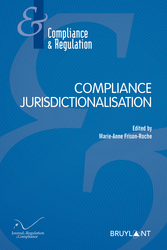Feb. 15, 2024
Thesaurus

► Full Reference: Ch. Lapp, "Compliance in Companies: The Statutes of the Process", in M.-A. Frison-Roche (ed.), Compliance Jurisdictionalisation, Journal of Regulation & Compliance (JoRC) and Bruylant, "Compliance & Regulation" Serie, 2024, pp. 155-166
____
📘read a general presentation of the book, Compliance Jurisdictionalisation, in which this article is published
____
► The summary below describes an article following the colloquium L'entreprise instituée Juge et Procureur d'elle-même par le Droit de la Compliance (The Entreprise instituted Judge and Prosecutor of itself by Compliance Law) , co-organized by the Journal of Regulation & Compliance (JoRC) and the Faculté de Droit Lyon 3. This manifestation was designed under the scientific direction of Marie-Anne Frison-Roche and Jean-Christophe Roda and took place in Lyon on June 23, 2021. During this colloquium, the intervention was shared with Jan-Marc Coulon, who is also a contributor in the book (see the summary of the Jean-Marc Coulon's Article).
In the book, the article will be published in Title I, devoted to: L'entreprise instituée Juge et Procureur d'elle-même par le Droit de la Compliance (The Entreprise instituted Judge and Prosecutor of itself by Compliance Law ).
____
► Summary of the article (done by the Author): The Company is caught in the grip of Compliance Law, the jaws of which are those of Incitement (1) and Sanction that the Company must apply to ensure the effectiveness of its processes to which it is itself subject (2 ).
First, the Company has been delegated to fabricate reprehensible rules that it must apply to itself and to third parties with whom it has dealings. To this end, the Company sets up "processes", that is to say verification and prevention procedures, in order to show that the offenses that it is likely to commit will not happened.
These processes constitute standards of behavior to prevent and avoid that the facts constituting the infringements are not themselves carried out. They are thus one of the elements of Civil Liability Law in its preventive or restorative purposes.
Second, the sanction of non obedience of Compliance processes puts the Company in front of two pitfalls. The first dimension place the company, with regard to its employees and its partners, in the obligation to define processes which also constitute the quasi-jurisdictional resolution of their non-compliance, the company having to reconcile the sanction it pronounces with the fundamental principles of classical Criminal Law, constitutional principles and all fundamental rights. The processes then become the procedural rule.
The second dimension is that the Company is accountable for the effectiveness of the avoidance by its processes of facts constituting infringements. By a reversal of the burden of proof, the Company is then required to prove that its processes are efficient. at least equivalent to the measures defined by laws and regulations, the French Anti-Corruption Agency (Agence Française Anticorruption - AFA), European directives and various communications on legal tools to fight breaches of probity, environmental attacks and current societal concerns. The processes then become the constitutive element, per se, of the infringement.
Thus, in its search for a balance between Prevention and Sanction to which it is itself subject, the Company will not then be tempted to favor the orthodoxy of its processes over the expectations of the Agence Française Anticorruption - AFA , regulators and judges, to the detriment of their efficiency?
In doing so, are we not moving towards an instrumental and conformist Compliance, paradoxically disempowering with regard to the Compliance Monumental Goals of Compliance?
____
🦉This article is available in full text to those registered for Professor Marie-Anne Frison-Roche's courses
________
Oct. 1, 2016
Thesaurus : Doctrine
Référence complète : L'ESMA et la sanction de Fitch : brèves réflexions sur les pouvoirs de surveillance de l'Autorité de surveillance de l'Autorité européenne des marchés financiers, Bulletin Joly Bourse, 1ier oct. 2016, p.423 s.
Il s'agit d'un commentaire - en français- de la sanction prononcée par l'ESMA (rédigée en anglais) le 21 juillet 2016 à l'encontre de l'agence de notation Fitch.
L'auteur souligne l'ampleur des pouvoirs de l'ESMA sur les agences de notation, qu'elle enregistre, qu'elle contrôle et qu'elle sanctionne, pouvoirs centralisés en son sein et non pas au sein des autorités nationales de supervision.
Le commentaire de la décision est critique, non pas tant sur le cas mais sur les textes qu'il concrétise.
En effet, les premiers pouvoirs sont ceux d'enquête et l'ESMA est venu contrôler la façon dont Fitch a pratiqué la notation des créanciers souverains. Or, la façon dont l'autorité européenne procède dans ces contrôles ne peut être contestée devant un juge, l'auteur estimant que cela n'est pas normal. En effet, l'ESMA peut faire des contrôles à l'intérieur même de l'entreprise sans aucune autorisation judiciaire, alors que par exemple les pouvoirs d'enquête de l'AMF sont encadrés.
Sur le fond, l'agence de notation a été sanctionnée car des employés n'avaient pas respecté l'obligation de confidentialité, les contrôles internes ayant été insuffisamment pour prévenir cette communication.
C'est cette même défaillance du contrôle interne qui est essentiellement reprochée à l'agence de notation à propos du délai de notification, qui n'a pas été respecté par les employés à l'égard de l'entité notée (ce qui est très grave pour celle-ci qui aurait pu fournir des éléments pouvant faire changer la note avant la publication de celle-ci), mais le contrôle interne n'avait pas averti les employés de l'agence de l'importance de ce délai.